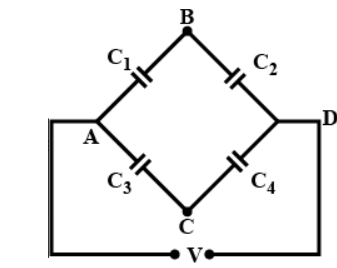
The potential difference between point B and C of the circuit is-
(A)\[\dfrac{{\left( {{C_2} - {C_1}} \right)}}{V}\]
(B)\[\dfrac{{\left( {{C_4} - {C_3}} \right)}}{V}\]
(C) \[\dfrac{{\left( {{C_2}{C_3} - {C_1}{C_4}} \right)}}{{\left( {{C_1} + {C_2} + {C_3} + {C_4}} \right)}}.V\]
(D) \[\dfrac{{\left( {{C_1}{C_4} - {C_2}{C_3}} \right)}}{{\left( {{C_1} + {C_2}} \right) \times \left( {{C_3} + {C_4}} \right)}}.V\]


Answer
554.7k+ views
Hint: As We know when capacitors are connected in series then the total capacitance will be the reciprocal of the individual capacitors that are connected. When the capacitors are connected in parallel combination then the total capacitance is the direct addition of the individual capacitances.
\[\dfrac{1}{{{C_S}}} = \dfrac{1}{{{C_1}}} + \dfrac{1}{{{C_2}}} + \dfrac{1}{{{C_3}}} + - - \]
\[{C_P} = {C_1} + {C_2} + {C_3} + - - - \]
Complete step by step answer:
In the arm ABD, the net voltage drop is equal to \[v\] volts and $C_1$ and $C_2$ are connected in series. So, the value of capacitance is-
\[\dfrac{1}{C} = \dfrac{1}{{{C_1}}} + \dfrac{1}{{{C_2}}}\]
\[C = \dfrac{{{C_1}{C_2}}}{{\left( {{C_1} + {C_2}} \right)}}\]
Charge will also be the same in series combination. So, \[Q = CV\]
Voltage across $C_2$ will be\[ = \Delta V\]\[ = \dfrac{Q}{{{C_2}}}\]
Here put the value of Q,
We get-\[\Delta V = \dfrac{{CV}}{{{C_2}}}\]
Substitute the value of C in this equation.
\[\Delta V = \dfrac{{{C_1}V}}{{{C_1} + {C_2}}}\]
\[{V_B} - {V_D} = \dfrac{{{C_1}V}}{{{C_1} + {C_2}}}\]
As we know potential at point D is \[0\]. So
\[{V_B} - 0 = \dfrac{{{C_1}V}}{{{C_1} + {C_2}}}\]
Similarly we can write, \[{V_c} - 0 = \dfrac{{{C_3}V}}{{{C_3} + {C_4}}}\]
Now we will calculate \[{V_B} - {V_C}\] ,
\[{V_B} - {V_C}\]\[ = \dfrac{{{C_1}V}}{{{C_1} + {C_2}}} - \dfrac{{{C_3}V}}{{{C_3} + {C_4}}}\]
\[ = \dfrac{{V({C_1}{C_4} - {C_3}{C_2})}}{{\left( {{C_3} + {C_4}} \right)\left( {{C_1} + {C_2}} \right)}}\]
So, potential difference between point B and C is\[ = \dfrac{{V({C_1}{C_4} - {C_3}{C_2})}}{{\left( {{C_3} + {C_4}} \right)\left( {{C_1} + {C_2}} \right)}}\].
So, the correct answer is “Option D”.
Note:
A capacitor is a device which is used to store electrical energy and charge which are available in many shapes and sizes. The amount of storage in a capacitor is calculated by a property named capacitance. There are two types of capacitance- Self capacitance and mutual conductance
The potential difference between two points is defined as the change in potential energy of a charge\[q\] moved from one point to another. Units of potential difference are \[joules\] per \[Coulomb\].
\[\dfrac{1}{{{C_S}}} = \dfrac{1}{{{C_1}}} + \dfrac{1}{{{C_2}}} + \dfrac{1}{{{C_3}}} + - - \]
\[{C_P} = {C_1} + {C_2} + {C_3} + - - - \]
Complete step by step answer:
In the arm ABD, the net voltage drop is equal to \[v\] volts and $C_1$ and $C_2$ are connected in series. So, the value of capacitance is-
\[\dfrac{1}{C} = \dfrac{1}{{{C_1}}} + \dfrac{1}{{{C_2}}}\]
\[C = \dfrac{{{C_1}{C_2}}}{{\left( {{C_1} + {C_2}} \right)}}\]
Charge will also be the same in series combination. So, \[Q = CV\]
Voltage across $C_2$ will be\[ = \Delta V\]\[ = \dfrac{Q}{{{C_2}}}\]
Here put the value of Q,
We get-\[\Delta V = \dfrac{{CV}}{{{C_2}}}\]
Substitute the value of C in this equation.
\[\Delta V = \dfrac{{{C_1}V}}{{{C_1} + {C_2}}}\]
\[{V_B} - {V_D} = \dfrac{{{C_1}V}}{{{C_1} + {C_2}}}\]
As we know potential at point D is \[0\]. So
\[{V_B} - 0 = \dfrac{{{C_1}V}}{{{C_1} + {C_2}}}\]
Similarly we can write, \[{V_c} - 0 = \dfrac{{{C_3}V}}{{{C_3} + {C_4}}}\]
Now we will calculate \[{V_B} - {V_C}\] ,
\[{V_B} - {V_C}\]\[ = \dfrac{{{C_1}V}}{{{C_1} + {C_2}}} - \dfrac{{{C_3}V}}{{{C_3} + {C_4}}}\]
\[ = \dfrac{{V({C_1}{C_4} - {C_3}{C_2})}}{{\left( {{C_3} + {C_4}} \right)\left( {{C_1} + {C_2}} \right)}}\]
So, potential difference between point B and C is\[ = \dfrac{{V({C_1}{C_4} - {C_3}{C_2})}}{{\left( {{C_3} + {C_4}} \right)\left( {{C_1} + {C_2}} \right)}}\].
So, the correct answer is “Option D”.
Note:
A capacitor is a device which is used to store electrical energy and charge which are available in many shapes and sizes. The amount of storage in a capacitor is calculated by a property named capacitance. There are two types of capacitance- Self capacitance and mutual conductance
The potential difference between two points is defined as the change in potential energy of a charge\[q\] moved from one point to another. Units of potential difference are \[joules\] per \[Coulomb\].
Recently Updated Pages
A man running at a speed 5 ms is viewed in the side class 12 physics CBSE

The number of solutions in x in 02pi for which sqrt class 12 maths CBSE

State and explain Hardy Weinbergs Principle class 12 biology CBSE

Write any two methods of preparation of phenol Give class 12 chemistry CBSE

Which of the following statements is wrong a Amnion class 12 biology CBSE

Differentiate between action potential and resting class 12 biology CBSE

Trending doubts
What are the major means of transport Explain each class 12 social science CBSE

Which are the Top 10 Largest Countries of the World?

Draw a labelled sketch of the human eye class 12 physics CBSE

How much time does it take to bleed after eating p class 12 biology CBSE

Explain sex determination in humans with line diag class 12 biology CBSE

Explain sex determination in humans with the help of class 12 biology CBSE




